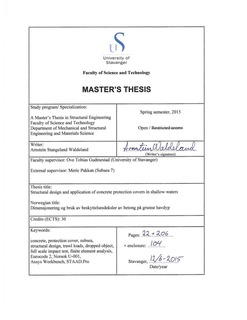| dc.description.abstract | The objective of this Master’s thesis was to investigate whether or not using protection
covers made of reinforced concrete is a viable option for protection of subsea installations
on the seabed. The main focus of the thesis is on the structural design of the cover. The
original problem, raised by Subsea 7, was that in shallow waters of about 100m depth, the
protection covers made of GRP experience problems with on-bottom stability due to the
hydrodynamic forces from currents and waves. Unless tons of ballast steel is added to
increase the mass of the cover, and rock-dumping on the sides of the cover is performed,
the covers are prone to be unstable or possibly moved by the currents and waves. The
hypothesis behind the thesis is that the slightly higher density of concrete and the thicker
walls of the concrete covers, as well as some slight changes to the typical shape of the
cover, will make them heavy enough to be stable on the seabed on its own without added
ballast weight and rock-dumping.
The type of cover assessed in the thesis is a simple tunnel or arch cover, which is typically used to cover pipelines or spools. The inner diameter of the cover was set to 2 m, so that it can protect pipelines or spools up to size 16” with the necessary clearances to walls and roof.
A 3D model of the reinforced concrete cover was created, and a finite element analysis
performed using the software Ansys® Workbench, Release 14.5. The trawl design loads of
300 kN from NORSOK standard U-001 was applied to the cover. A dynamic dropped object
simulation on the reinforced concrete cover model was also performed. The analyses
showed that the concrete protection covers had sufficient strength to withstand the force
from the trawl board and to withstand the energy from the dropped objects without
damaging the product underneath.
A 2D beam model of the cover was created in STAAD.Pro V8i in order to get the design
forces and moments in the cover. The concrete protection cover was designed according to
the concrete standard Eurocode 2. This design resulted in the necessary amount of
reinforcement to withstand the design forces and moments, and proved that the cross-section of concrete and reinforcement of the protection cover was able to withstand the
design loads from trawl gear impacts.
A full scale dropped object test of impact energies 5 kJ, 20 kJ, 30 kJ and 50 kJ, according to NORSOK standard U-001 was performed on doubly reinforced concrete protection covers of
215 mm thickness and inner radius of 1000 mm. The test was performed on concrete
covers provided by Multiblokk AS. The objects used in the test had masses of 140 kg, 550
kg, 850 kg and 1400 kg and was dropped onto the cover from approximately 3,7 m height.
An initial test was performed on gravel on Multiblokk AS’ premises, and the four main tests
were performed with the cover submerged in the basin at the laboratories at the University
of Stavanger. The covers in the main tests cracked slightly, but none were penetrated or
collapsed. The dropped object tests proved that the strength of the protection covers was
more than enough to withstand the dropped object energies, and that the initial design of
the cover is suitable to build upon further.
Based on the results from the structural assessment of the cover, the tests and analyses, the concept of using concrete protection covers was found to be a feasible concept that should be investigated further and in more detail. Its heavy weight, high strength and the
possibility of liberation from rock-dump requirements gives the concrete protection cover
a competitive edge that is well worth exploring further. | nb_NO |

